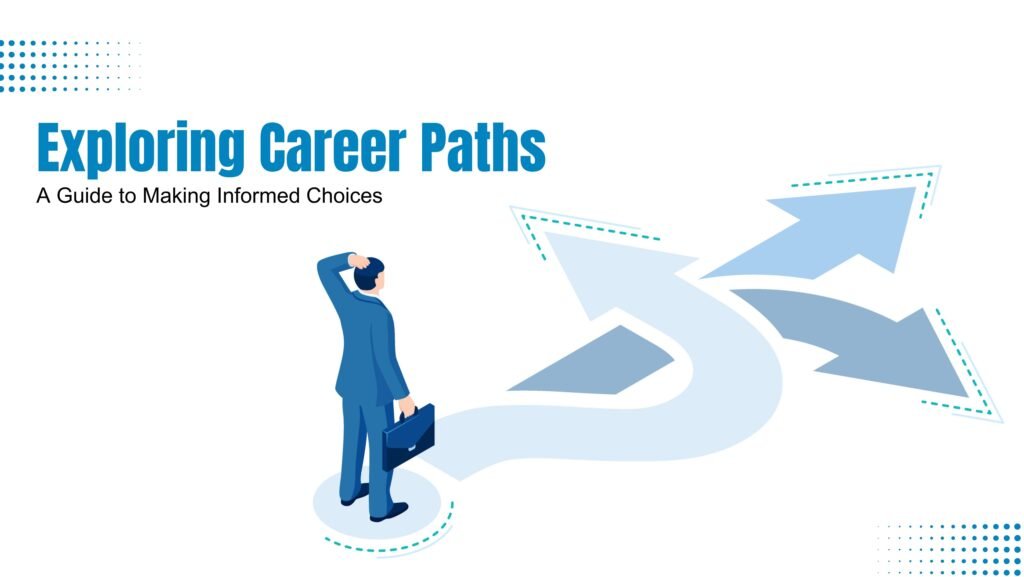Choosing the right career path is a crucial decision that significantly impacts various aspects of your life. Not only does it influence your financial stability, but it also plays a pivotal role in determining your overall well-being.
Your chosen profession shapes your daily experiences, personal growth, and future aspirations. It’s like laying the foundation for a successful and fulfilling life.
Welcome to “Exploring Career Paths: A Guide to Making Informed Choices.” This guide is here to support you as you embark on the journey of finding a career that resonates with your passions and abilities.
Whether you’re a high school student, recent graduate, or an individual seeking a career transition, our goal is to offer practical advice and valuable insights to empower you in making well-informed decisions.
Understanding Yourself
Building on our previous conversation about interests, it’s crucial to acknowledge that your passions often act as navigators, directing you towards a rewarding career. Your interests hold the key to discovering a vocation that doesn’t feel like a chore. They embody what genuinely excites you and keeps you engaged.
“Choose a Job you Love and, you’ll never have to work a day in your life”—Confucius
- To identify your interests, reflect on the activities or topics that you naturally gravitate towards during your spare time.
Consider what you would gladly engage in for hours without any monetary incentive. Whether it’s art, technology, assisting others, problem-solving, or any other passion that sparks your curiosity and enthusiasm, recognizing your interests is an important stride towards finding a rewarding career path.
- Additionally, you may consider utilizing career assessment tests and surveys to gain further insights into professions that align closely with your interests.
Recognizing Strengths and Weaknesses:
- Self-awareness is a cornerstone of recognizing your strengths and weaknesses. Your strengths are the unique skills, traits, or talents that come naturally to you. These can include creativity, organization, leadership, or problem-solving, among others. Acknowledging your strengths allows you to leverage them to your advantage in your career.
- Equally important is an understanding of your weaknesses, areas where you may need improvement. Recognizing these areas is an opportunity for growth. It enables you to plan for skill development and personal development, either through training, mentorship, or simply by being mindful of areas that require more attention.
Self-reflection, feedback from mentors or peers, and tools like SWOT analysis can all help you identify your strengths and weaknesses.
Goal settings and Career Objective:
Effective goal setting is a cornerstone of career planning. By setting clear, achievable career objectives, you create a structured path for your professional growth.
- Goals can encompass both short-term and long-term aspirations. Short-term goals may include gaining specific skills, experiences, or certifications, while long-term goals could involve achieving a particular job title, income level, or even starting your own business.
- Your goal objectives will act as signposts on your career journey, enabling you to measure your progress, track your accomplishments, and adjust your path as needed.
This comprehensive understanding of yourself, including your interests, strengths, weaknesses, values, and career objectives, forms the solid base upon which you’ll make well-informed career choices that align with your unique aspirations and potential. Your journey towards a fulfilling career is built on self-awareness and guided by your individual compass of interests, values, and objectives.
Researching Career Options:
In this crucial step of your career exploration, we’ll show you how to tap into online resources, such as career websites and forums, to gain insights into different professions. You’ll also learn the art of networking to connect with professionals and explore the world of job shadowing to experience various careers firsthand.
- Online Resources: The internet is your gateway to a vast array of career-related information. Numerous websites and resources can help you explore various career options.
Visit career websites like LinkedIn, Indeed, or Glassdoor to read about job descriptions, skills required, and real-life experiences of professionals.
Industry-specific forums and social media groups can also provide valuable insights into different careers. These online platforms are essential tools for collecting data that will inform your career decisions.
- Networking: Networking is a powerful tool for career research. Connecting with professionals in your desired fields can give you firsthand knowledge about what it’s like to work in a particular industry.
There are various strategies for networking, including attending industry events, reaching out to alumni, and conducting informational interviews.
Building a network can help you gather valuable insights and potential job opportunities.
- Job Shadowing: Job shadowing allows you to experience a day in the life of a professional. It’s an excellent way to gain a deeper understanding of the roles and responsibilities associated with different careers.
To arrange job shadowing experiences, reach out to professionals willing to host you. During these experiences, observe the tasks, responsibilities, and work environment. This hands-on approach will help you gain a realistic sense of whether a career aligns with your expectations and interests.
Apart from these mentioned options, there lies another point that is Job Market Trends. To make informed career decisions, stay updated on job market trends.
- Begin by researching the demand for specific professions.
- Analyze whether the field you’re interested in is growing, stable, or declining. Look into salary expectations, considering the industry, location, and level of experience.
- Also, take into account geographic variations – some careers might be in high demand in one region but not in another. Understanding these trends will help you make choices that align with long-term career stability and growth.
Narrowing Down Options and Finalizing Your Decision
After thorough research, it’s time to create a shortlist of potential careers that resonate with your interests, strengths, and values. These should be the careers that align most closely with your aspirations and expectations. While it’s essential to keep your options open, a focused list simplifies the decision-making process.
Comparing and Contrasting different options: Compare the potential earnings and benefits associated with each career on your shortlist. Consider factors like starting salary, growth potential, and additional perks. Balance your financial expectations with your overall career satisfaction.
Work-Life Balance: Reflect on the work-life balance each career offers. Does it align with your personal priorities? Some careers may demand long hours, while others allow for more flexible schedules. Consider how your chosen path will affect your personal life.
Job Satisfaction: Job satisfaction is vital for long-term career success. Examine how each career on your shortlist aligns with your passions and interests.
Will the work be engaging and fulfilling? Consider the potential for growth and advancement, as well as opportunities for continuous learning.
Seeking guidance from Mentors or Career Counselors: Don’t hesitate to seek guidance from experienced professionals or career counselors.
They can provide valuable insights and help you make informed decisions. Mentors, in particular, can share their experiences and offer advice on the paths you’re considering.
Conducting a final self-assessment: Before making your final decision, conduct one last self-assessment. Reflect on your interests, strengths, and values, and assess how well they align with the careers on your shortlist. Take into account your personal and professional goals, as well as any changes or developments that have occurred during your research.
Weighing Pros and Cons of the Selected Career Path: Evaluate the pros and cons of each career option you’ve narrowed down. Consider factors like job security, growth potential, personal fulfillment, and lifestyle fit.
Create a list of advantages and disadvantages for each choice. This exercise will provide you with a clear picture of what you stand to gain and what you might need to sacrifice in each career.
Once you’ve weighed all the factors and considered your self-assessment, it’s time to make a commitment to your chosen career path. This decision should be well-informed and align with your long-term goals. Remember that commitment is a crucial step in achieving success in your chosen career. Be prepared to invest time and effort in your chosen path, continuously learning and growing along the way.
By combining these steps, you’ll create a structured decision-making process that helps you narrow down your options and finalize your career choice with confidence.







